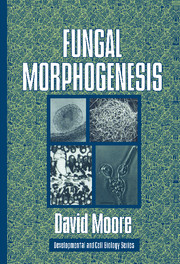Book contents
7 - The Keys to Form and Structure
Published online by Cambridge University Press: 31 March 2010
Summary
I will now attempt to summarise the discussion and present an interpretation of plausible mechanisms for control of fungal morphogenesis. Because the data are so fragmentary, this will involve extensive generalisations and potentially outrageous extrapolations. I am aware of the dangers of over-interpretation. Generalisations from a few specific cases which combine incomplete information from organisms of arguable comparability does not make the best science. At the moment there is not much choice. My motive is to produce a developmental model which can be tested by further research. So this chapter comes with the challenge: if you don't like the ideas presented here, then fill the gaps in the knowledge. Do the research to prove me wrong.
The nature of morphogenetic control
The first lesson to learn from other organisms bears on the question of the ultimate level of morphogenetic control. It is clear that in animals and plants morphogenesis is not simply a matter of playing out a predefined genetic program and it is likely that this will be true for fungi also. Goodwin (1984) states that the “developmental process involves principles of organisation which are not caused by genes in the way that computer output is caused by a program.” Instead, he argued that macro-molecular and cellular structures, such as the cytoskeleton and endomembrane system, provide a more promising foundation for describing the forces which define morphogenetic fields during animal embryogenesis.
- Type
- Chapter
- Information
- Fungal Morphogenesis , pp. 392 - 404Publisher: Cambridge University PressPrint publication year: 1998

